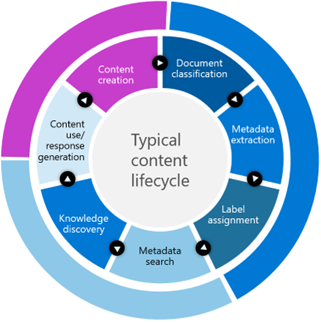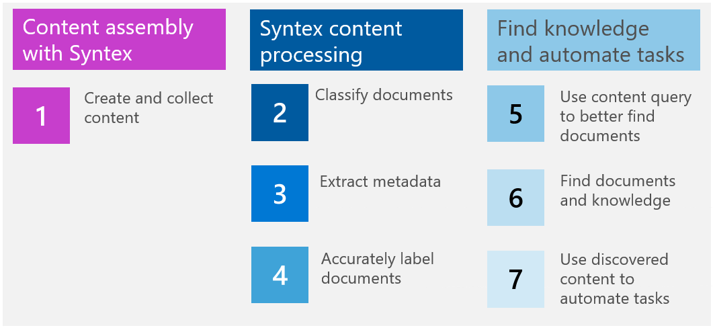Introduction
You can only do so much with the time you have in a day. With thousands of documents circulating throughout your organization in just a week, how do you make real sense of the information efficiently and profitably? Microsoft Syntex is a set of content Artificial Intelligence (AI) services, available as a premium offering with Microsoft 365 to help you discover information, process content, and ensure content compliance with your organization’s documents stored in SharePoint. Syntex uses AI to automatically read, tag, and index high volumes of content and connect it where it’s needed—in search, in applications, and as reusable knowledge. Syntex manages your content throughout its lifecycle with robust analytics, security, and automated retention.
Rather than clicking and sorting through hundreds, or even thousands of files, Microsoft Syntex extracts data for you, streamlining the search and discovery process. This returns valuable time to you and your team. You are able to not only dive deeper into your content to understand it, but also increase document insight and control. In addition, when combined with other Microsoft AI services, Syntex can save you time with frequent tasks, like sending emails to people and creating forms and new documents.
Introducing Contoso Electronics
In this module, let’s imagine Contoso Electronics, a leading industrial group in the consumer electronics sector. The company operates in 20 countries/regions through approximately 25 companies, involving more than 20,000 people including vendors, contractors, and partners from 50 nationalities worldwide.
Contoso Electronics manages many projects each year, which means the production and maintenance of millions of documents. More than 20 departments across the company, along with their clients, share and collaborate on these documents, resulting in numerous versions.
Due to the large volume of documents, the engineering support team needed to have a substantial number of members to manage them effectively. On average, it took the team five days to complete the task of reviewing all the documents.
Given the company’s focus on innovation, employees at Contoso Electronics are quick and eager to incorporate Syntex to manage their documents. In the following units, you’ll come to know how Contoso Electronics uses Syntex to handle their documents through various stages of a typical content lifecycle.
Note
Although Contoso Electronics is used for the scenarios in this module, these scenarios are applicable to all organizations who need to better understand, store, process, and generate documents, irrespective of industry or size.
What can Syntex do?
To understand how Microsoft Syntex can help with the way you handle your documents, let’s first look at a typical content lifecycle:

As shown in the graphic, a typical content lifecycle contains seven stages:
- Content creation
- Document classification
- Metadata extraction
- Label assignment
- Metadata search
- Knowledge discovery
- Content use/response generation
Syntex optimizes various stages of a typical content lifecycle, with content AI tools and services. The following diagram gives you a quick overview of how Syntex helps in each stage:

Content assembly helps you with generating repeatable content at scale.
Content processing helps you to:
- Extract, tag, and index content
- Recognize objects and text in images
- Annotate files without affecting the original
- Translate and summarize documents
- OCR (Optical Character Recognition) and transcription
Content query helps you to find the documents by searching based on content's key information, such as document creation date, content type, people, due date, or other key information extracted by document processing models.
Content workflow automation helps you to:
- Integrate into other business processes such as SharePoint, Power Automate, Office, OneDrive, Loop, and Stream
- Analyze and protect with AI-driven security and compliance
Syntex licensing
Microsoft Syntex uses pay-as-you-go licensing. With pay-as-you-go, you can use Syntex without any license commitment or upfront purchasing. Any user in your organization can use Syntex services and only pay if and when services are used.
Pay-as-you-go requires an Azure subscription. Pay-as-you-go services are billed based on the type and number of transactions.
Note
Syntex is not part of Microsoft Viva licensing. You can monitor your Syntex pay-as-you-go usage in Microsoft Cost Management for Azure. If you want to use Syntex in combination with Power Automate and Power Apps, you'll need to have licenses for them.
In this unit, you learned about what is Syntex, and how it can help you throughout various stages of content lifecycle. In the next unit, you'll see when real-world organizations use Syntex to help them manage documentation.